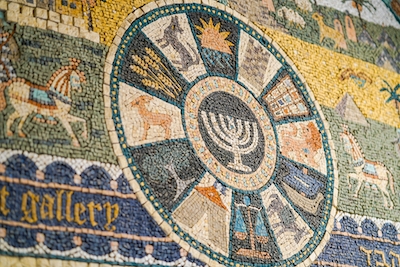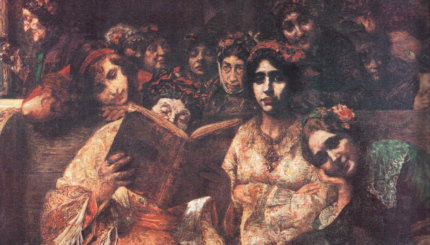Reproduced with permission from Teaching Jewish Holidays: History Values and Activities (A.R.E. Publishing, Inc.).
On the eve of Tisha B’Av, at the final meal before fasting, it is customary to eat a boiled egg as a symbol of mourning and to sprinkle ashes on the egg. Grace after this meal is said individually and in silence.
The traditional mourning code governs the day itself–abstinence from eating, drinking, bathing, or participating in any kind of festive occasion from sunset to sunset; washing of the body is forbidden except to clean the face; sexual intimacy is not permitted; shoes made of leather are not to be worn; in the home or synagogue, shoes are removed and everyone sits on low benches as if to emulate mourners sitting shiva [the week-long mourning period for relatives]. 
Only melancholy passages from the , the Book of Job, prophecies of misfortune in Jeremiah, and the laws of mourning and other similar passages which serve to sadden the heart are studied. Visiting the cemetery is encouraged as if to heighten the sadness of the day.

Help us keep Jewish knowledge accessible to millions of people around the world.
Your donation to My Jewish Learning fuels endless journeys of Jewish discovery. With your help, My Jewish Learning can continue to provide nonstop opportunities for learning, connection and growth.
In the synagogue, the parohet [covering]is removed from before the Ark, the pulpit cover is taken away, the lights are turned low, the reader and other congregants sit on low stools, and they do not greet each other. Tallit and tefillin are not worn during the morning service, but instead are worn for Minchah [the afternoon service]. It is as if the Jewish world is turned upside down.
Highlights of the Liturgy
Modifications are also made in the liturgy of the synagogue for Tisha B’Av: The regular weekday services are used; however, in the evening service, the Book of Lamentations is read, followed by several kinot [poems of lamentation]. An extra prayer is inserted in the Amidah [the central “standing” prayer]. Both the morning and the afternoon services contain a Torah and a haftarah [prophetic] reading.
A variety of customs unique to specific communities have been linked to Tishah B’Av, but none has become universally adopted.


